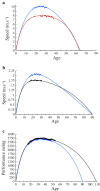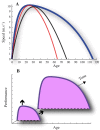Exponential growth combined with exponential decline explains lifetime performance evolution in individual and human species
- PMID: 21695422
- PMCID: PMC3682058
- DOI: 10.1007/s11357-011-9274-9
Exponential growth combined with exponential decline explains lifetime performance evolution in individual and human species
Abstract
The physiological parameters characterizing human capacities (the ability to move, reproduce or perform tasks) evolve with ageing: performance is limited at birth, increases to a maximum and then decreases back to zero at the day of death. Physical and intellectual skills follow such a pattern. Here, we investigate the development of sport and chess performances during the lifetime at two different scales: the individual athletes' careers and the world record by age class in 25 Olympic sports events and in grandmaster chess players. For all data sets, a biphasic development of growth and decline is described by a simple model that accounts for 91.7% of the variance at the individual level and 98.5% of the variance at the species one. The age of performance peak is computed at 26.1 years old for the events studied (26.0 years old for track and field, 21.0 years old for swimming and 31.4 years old for chess). The two processes (growth and decline) are exponential and start at age zero. Both were previously demonstrated to happen in other human and non-human biological functions that evolve with age. They occur at the individual and species levels with a similar pattern, suggesting a scale invariance property.
Figures



References
Publication types
MeSH terms
LinkOut - more resources
Full Text Sources
Medical
